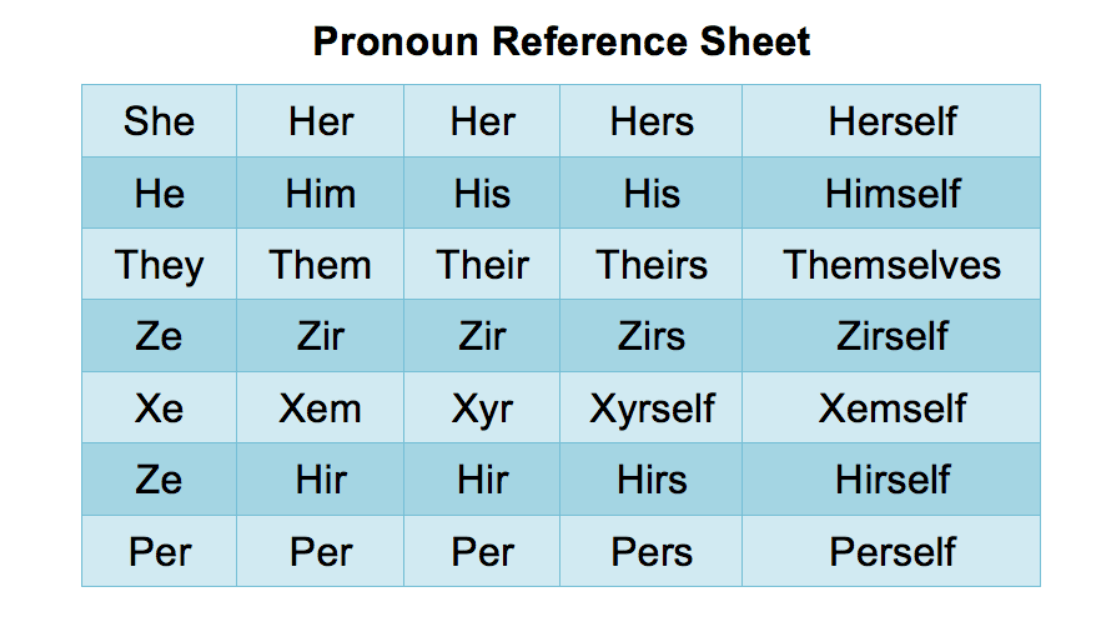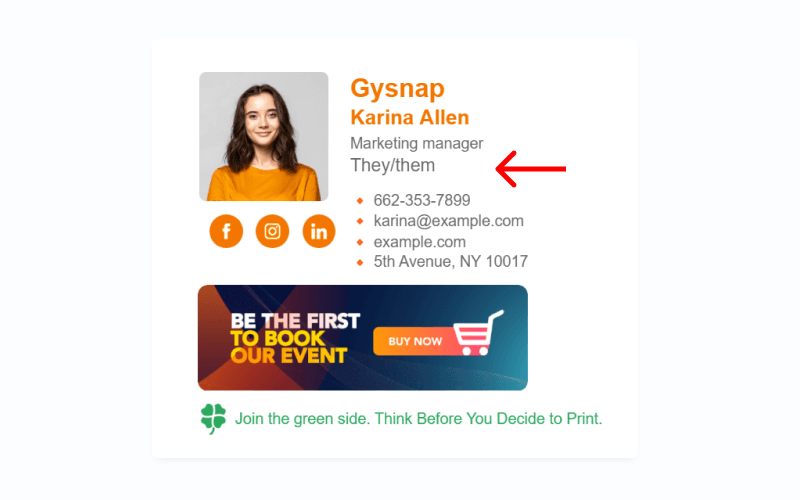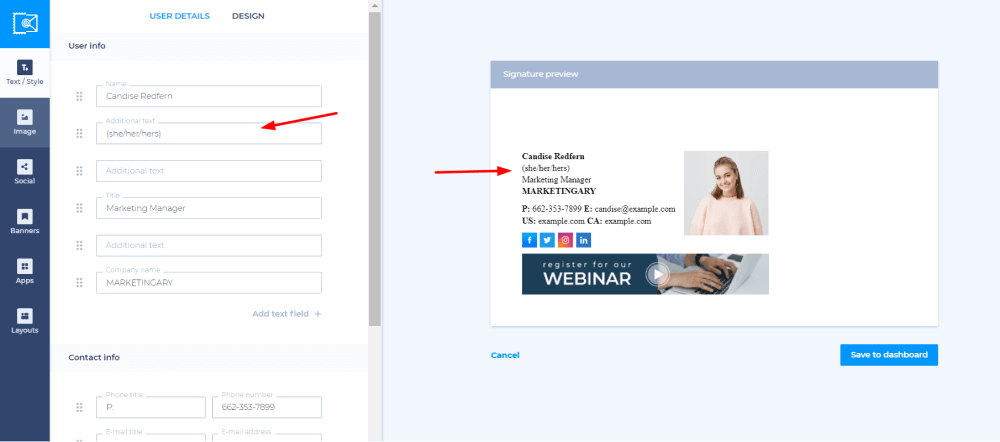How to Use Gender Pronouns in Email Signature
1. What are gender pronouns in business email communication?
2 . Why are gender pronouns important?
3. How can you mention pronouns in your email?
4. Is it necessary to include gender pronouns in email signatures?
5. Examples of gender pronouns in email signatures
6. Adding pronouns to your company's email signatures is easy with Newoldstamp!
The way people think about gender is becoming more inclusive, moving beyond just "male" and "female." This means people are using pronouns like "they/them" and "she/her" to show how they identify. You might see these pronouns on social media profiles, business cards, or even in professional email signatures.
For many transgender people, this is a convenient way to clearly show others the pronouns by which they would like to be referred to. However, you might also see cisgender people (those who identify with the sex assigned to them at birth) including pronouns in their email signatures too.
If you're interested in being more inclusive, this article is for you! We'll explain why using gender pronouns in email signatures is important, give you examples of different pronouns, and even show you how to easily add gender pronouns to email signatures.

source: Ualberta
What are gender pronouns in business email communication?
Gender pronouns are words that a person prefers other people to use when talking to or about them. They reflect a person's gender identity, which is how they feel and identify themself, regardless of their assigned sex at birth. Using the correct pronouns is a way to respect and acknowledge their identity.
Here are some common pronouns and who they might be used for:
- He/Him/His: For someone who identifies as male.
- She/Her/Hers: For someone who identifies as female.
- They/Them/Their: For someone who identifies as gender-neutral or someone who doesn't identify as either male or female.
There are also other pronouns, and some people even use a combination of pronouns. For example:
- Ze/hir/hirs can replace both he/him/his and she/her/hers.
- Ey/em/eirs can replace both he/him/his and she/her/hers.
➖ “Each team leader is responsible for his/her team.”
➕ “Each team leader is responsible for their team.”
So, why does sharing gender pronouns at work matter?
Why are gender pronouns important?
Using someone's preferred pronouns isn't just about grammar, it's about respect and creating a welcoming environment.
 |
"Including pronouns in your email signature and social media profiles is an important move towards inclusivity." Gina Battye LGBT+ Inclusion Consultant |
source: Forbes
Even though you might identify as cisgender, adding your pronouns to your email signature is a simple way to show others that you acknowledge and respect everyone's gender identity. It might seem like a small thing, but it can make a big difference to people in the LGBTQ+, non-binary, transgender, and gender non-conforming communities. This simple act supports gender equality.
-
Lead by example
Not every transgender or non-binary person feels brave enough to start sharing gender pronouns in emails at a new workplace, especially when no one else on the team does the same.
In such situations, cisgender people can lead the change by sharing gender pronouns. This can encourage others, especially those within the transgender, non-binary, and gender non-conforming communities, to feel comfortable sharing theirs too.
-
Don't assume someone's gender
Adding pronouns to your email opens the door for others to share theirs if they'd like, without having to be directly asked.
-
Asking about pronouns politely
If someone hasn't shared their pronouns, you can ask politely. Here are some respectful ways to do so:
- "Please tell me your name, role, and if you're comfortable sharing your gender pronouns."
- "Could you remind me of which pronouns you use?"
- "What are your gender pronouns?"
Remember: It's normal to make mistakes sometimes, especially as this is a new concept for many people. The important thing is to be open to learning and correcting yourself respectfully if you make a mistake.
How can you mention pronouns in your email?
Here are some easy ways companies can introduce gender pronouns into their email communication:
Adding pronouns to an email signature
All employees can add their preferred pronouns in email signatures. This ensures everyone has the opportunity to display their gender identity and avoids unintentionally using the wrong pronoun, which can be hurtful and disrespectful.
Companies can choose to add commonly preferred pronouns (e.g., he/him/his, she/her/hers, they/them/theirs) next to the name or job title in the signature.
Mentioning in the text of an email
Another good option is adding a brief introduction at the start of your email mentioning your pronouns. For example, "I'm Natalie, and I use they/them/their pronouns."
Adding in brackets near your name
You can also add your preferred gender pronouns near your name at the end of the email. For example, “Best regards, Natalie (they/them/their).”
This placement offers another way to share your pronoun list while maintaining a traditional email signature format.
Related: “The Most Effective Ways to Structure Your Email Signatures to Kickass Your Business Communication.”
Is it necessary to include gender pronouns in email signatures?
Adding your pronouns to your work email signature helps everyone know how to address you and others respectfully. This simple act fosters a culture of inclusivity, which is becoming an important part of email signature etiquette.
Think of it this way: emails are part of everyday communication, so your signature with pronouns becomes a visible sign of support for people of different genders. This commitment to inclusivity can resonate with colleagues, clients, and anyone else you connect with. And you never know who might appreciate your company taking the extra step to be welcoming and respectful.
Ultimately, you decide whether or not to include your pronouns in your signature. But remember, it's a simple way to be more considerate and contribute to a more inclusive, respectful environment.
Should I make using gender pronouns in email signatures mandatory for my team?
No, it shouldn't be compulsory. Everyone adapts to new ideas at their own pace, and that's perfectly fine.
Here are some tips for introducing pronouns to your team in an optional way:
- Open a conversation. Talk to your team about why you think including pronouns is positive for inclusivity.
- Gather feedback. Let everyone share their thoughts and concerns.
- Make it a choice. Explain that using pronouns in email communication is optional, and staff can choose to include them or not.
- Respect individual decisions. Some people may be comfortable, while others may need more time to adjust.
If your company uses a central email signature management solution (like Newoldstamp), it usually simplifies adding pronouns for those who choose to do so.
Examples of gender pronouns in email signatures
Wondering where to add your gender pronouns in your email signature?
Here are five examples of how you can effortlessly incorporate your pronouns into your email signature:
- Next to your name:
_(1).png?1709567439)
- After your job title:
.png?1709567990)
- On a separate line after your name:
.png?1709567946)
- Below all your contact information:
_(1).png?1709567588)
- On a separate line after your job title:

By incorporating pronouns, you contribute to creating a more welcoming and respectful environment in professional email communication.
Bonus tips:
- Choose the placement that best fits your signature style.
- Be consistent within your company if you have a large team.
- Encourage, but don't require, your employees to add pronouns to email signatures.
Adding pronouns to your company's email signatures is easy with Newoldstamp!
Newoldstamp is an email signature generator that makes it easy for businesses of all sizes to manage their company email signatures, including adding preferred gender pronouns alongside other important information like contact details and personal details.
Here's how Newoldstamp simplifies the process:
- Choose an email signature template: Select a template you like from Newoldstamp's library or create your own custom template using the drag-and-drop editor.

- Add a pronoun placeholder: Within the template, designate a specific location where pronouns will be displayed, such as next to your name or below your job title.

- Apply changes company-wide: Newoldstamp offers seamless integration with major platforms like Google Workspace, Microsoft 365, and Exchange, ensuring automatic updates across your entire company's email signatures. This solution is also compatible with popular email clients like Gmail, Outlook, Thunderbird, and Apple Mail, guaranteeing company-wide consistency.
.png?1709565698)
With Newoldstamp, adding pronouns to your company's email signatures is a quick and easy process that promotes inclusivity and respect within your organization.
Conclusion
More and more companies are encouraging employees to include gender pronouns in their email signatures. This new practice helps reduce misgendering and is an essential strategy for inclusivity.
It brings awareness to something that lots of people might not have thought about before.
Do you want to start practicing these values already? Create your new email signature and share personal gender pronouns easily and professionally.




